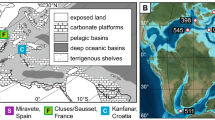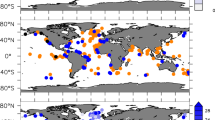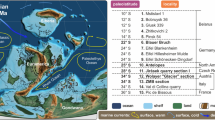Abstract
The oxygen isotopic compositions of tests of Foraminifera are quantitatively related to global ice volume1,2 and local temperature and salinity conditions in which the Foraminifera grew3–8. Thus, a well-preserved sample of deep-sea core contains information about sea-surface temperature (shallow-dwelling planktonic Foraminifera), structure of the thermocline (deeper-dwelling planktonic Foraminifera), and bottom water temperature (benthic Foraminifera), and the global ice volume effect is also superimposed. The progress which has been made in calibration of core–top isotopic data to modern oceanographic data5,7,8, has led us to test state-of-the-art core–top methodology and calibration on a late Miocene time slice (6.0 ± 0.5 Myr BP) of the Atlantic Ocean. Samples studied can be related to either uppermost Zone NN11 or lowermost NN12 of Martini9 and uppermost Zone N17 of Blow10.
This is a preview of subscription content, access via your institution
Access options
Subscribe to this journal
Receive 51 print issues and online access
$199.00 per year
only $3.90 per issue
Buy this article
- Purchase on Springer Link
- Instant access to full article PDF
Prices may be subject to local taxes which are calculated during checkout
Similar content being viewed by others
References
Shackleton, N. J. Nature 215, 15–17 (1967).
Shackleton, N. J. & Opdyke, N. D. Ouat. Res. 3, 39–55 (1973).
Epstein, S., Buchsbaum, R., Lowenstam, H. & Urey, H. C. Bull. geol. Soc. Am. 64, 1315–1326 (1953).
Emiliani, C. J. Geol. 74, 109–126 (1966).
Williams, D. F. thesis, Univ. Rhode Island Grad. School Oceanogr. (1976).
Williams, D. F. Trans. Am. geophys. Un. 59, 297 (1978).
Shackleton, N. J. & Vincent, E. Mar. Micropaleont. 3, 1–13 (1978).
Curry, W. B. thesis, Brown Univ. (in preparation).
Martini, E. in Proc. 2nd Planktonic Conf. (ed. Farinacci, A.) 739–785 (Tecnoscienza, Roma, 1971).
Blow, W. H. in Proc. 1st Planktonic Conf. (eds Bronnimann, P. & Renz, H. H.) 199–422 (Brill, Leiden, 1969).
Oba, T. Sedai Tohoku Univ. Sci. Rep. 2nd Ser. (Geol.) 41, 129–195 (1969).
Berger, W. H. Deep Sea Res. 16, 1–24 (1969).
Be, A. W. H. & Tolderlund, D. S. in Micropaleontology of the Oceans (eds Funnell, B. M. & Riedel, W. R.) 105–149 (Cambridge University Press, London, 1971).
Curry, W. B. & Matthews, R. K. Trans. Am. geophys. Un. 60, 274 (1979).
Be, A. W. H. in Oceanic Micropaleontology (ed. Ramsey, A. T. S.) 1–100 (Academic, London, 1977).
Author information
Authors and Affiliations
Rights and permissions
About this article
Cite this article
Matthews, R., Curry, W., Lohmann, K. et al. Late Miocene palaeo-oceanography of the Atlantic: oxygen isotope data on planktonic and benthic Foraminifera. Nature 283, 555–557 (1980). https://doi.org/10.1038/283555a0
Received:
Accepted:
Issue Date:
DOI: https://doi.org/10.1038/283555a0
This article is cited by
-
Evolutionary history biases inferences of ecology and environment from δ13C but not δ18O values
Nature Communications (2017)
-
Effects of diagenetic recrystallization on 18O/16O values of deep-sea sediments
Nature (1983)
Comments
By submitting a comment you agree to abide by our Terms and Community Guidelines. If you find something abusive or that does not comply with our terms or guidelines please flag it as inappropriate.



